Lepton Flavour Universality in Rare B Decays
Abstract
:1. Introduction
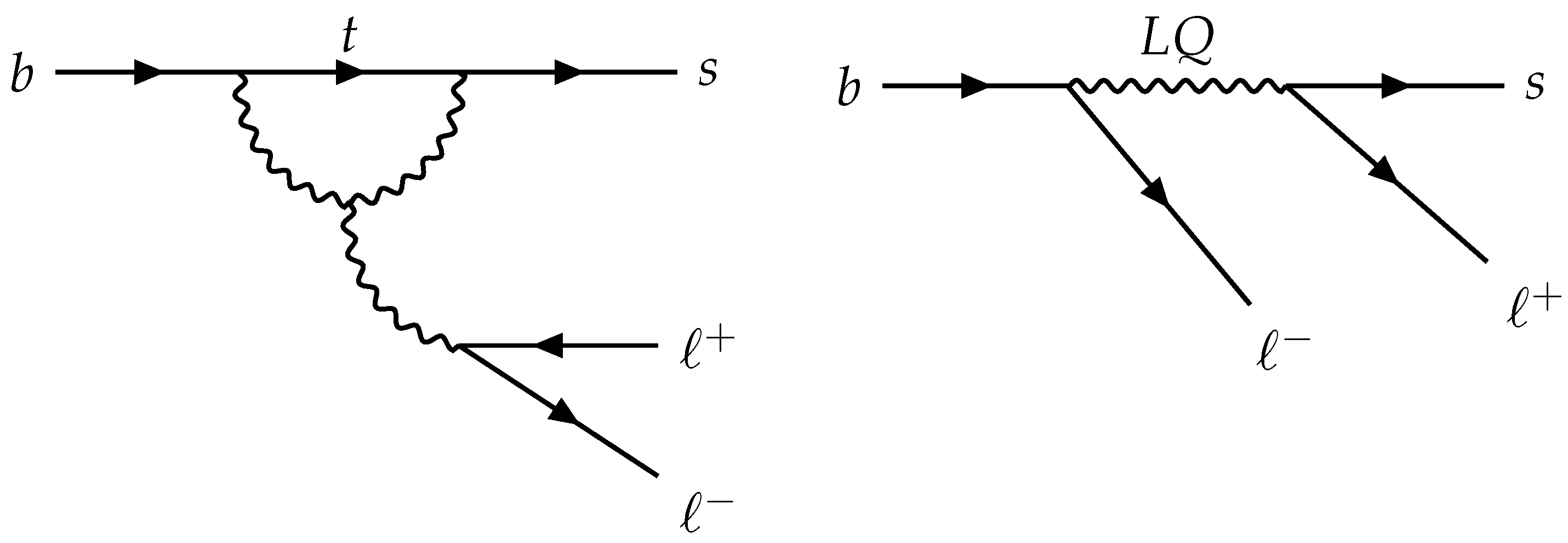
2. Experimental Challenge
3. Semileptonic Decays
Angular Observables
4. Fully Leptonic Decays
5. Decays Involving Leptons
6. Prospects
7. Conclusions
Author Contributions
Funding
Data Availability Statement
Acknowledgments
Conflicts of Interest
References
- Particle Data Group. Review of particle physics. PTEP 2022, 2022, 083C01. [Google Scholar] [CrossRef]
- Jung, M.; Pich, A.; Tuzon, P. Charged-Higgs phenomenology in the aligned two-Higgs-doublet model. J. High Energy Phys. 2010, 11, 003. [Google Scholar] [CrossRef]
- Hiller, G.; Schmaltz, M. RK and future b→sℓℓ physics beyond the standard model opportunities. Phys. Rev. D 2014, 90, 054014. [Google Scholar] [CrossRef]
- Tanaka, M. Charged Higgs effects on exclusive semi-tauonic B decays. Zeitschrift für Physik C Particles and Fields 1995, 67, 321–326. [Google Scholar] [CrossRef]
- LHCb Collaboration. Branching Fraction Measurements of the Rare Bs0→ϕμ+μ− and Bs0→f2′(1525)μ+μ−-Decays. Phys. Rev. Lett. 2021, 127, 151801. [Google Scholar] [CrossRef] [PubMed]
- LHCb Collaboration. Measurements of the S-wave fraction in B0→K+π-μ+μ− decays and the B0→K*(892)0μ+μ− differential branching fraction. JHEP 2017, 11, 047, Erratum in: JHEP 2017, 04, 142. [Google Scholar] [CrossRef]
- LHCb Collaboration. Differential branching fraction and angular analysis of Λb0→Λμ+μ− decays. JHEP 2018, 06, 115. [Google Scholar] [CrossRef]
- LHCb Collaboration. Differential branching fractions and isospin asymmetries of B→K(*)μ+μ− decays. JHEP 2014, 06, 133. [Google Scholar] [CrossRef]
- LHCb Collaboration. Measurement of CP-averaged observables in the B0→K*0μ+μ− decay. Phys. Rev. Lett. 2020, 125, 011802. [Google Scholar] [CrossRef]
- CMS Collaboration. Measurement of angular parameters from the decay B0→K*0μ+μ− in proton-proton collisions at = 8 TeV. Phys. Lett. B 2018, 781, 517–541. [Google Scholar] [CrossRef]
- ATLAS Collaboration. Angular analysis of Bd0→K*μ+μ− decays in pp collisions at = 8 TeV with the ATLAS detector. JHEP 2018, 10, 047. [Google Scholar] [CrossRef]
- LHCb Collaboration. Angular analysis of the B0→K*0μ+μ− decay using 3 fb−1 of integrated luminosity. JHEP 2016, 02, 104. [Google Scholar] [CrossRef]
- BaBar Collaboration. Measurements of branching fractions, rate asymmetries, and angular distributions in the rare decays B→Kℓ+ℓ− and B→K*ℓ+ℓ−. Phys. Rev. D 2006, 73, 092001. [Google Scholar] [CrossRef]
- Belle Collaboration. Measurement of the differential branching fraction and forward-backward asymmetry for B→K(*)ℓ+ℓ−. Phys. Rev. Lett. 2009, 103, 171801. [Google Scholar] [CrossRef]
- CDF Collaboration. Measurements of the angular distributions in the decays B→K(*)μ+μ− at CDF. Phys. Rev. Lett. 2012, 108, 081807. [Google Scholar] [CrossRef]
- Belle Collaboration. Lepton-flavor-dependent angular analysis of B→K*ℓ+ℓ−. Phys. Rev. Lett. 2017, 118, 111801. [Google Scholar] [CrossRef]
- LHCb Collaboration. Angular moments of the decay Λb0→Λμ+μ− at low hadronic recoil. JHEP 2018, 09, 146. [Google Scholar] [CrossRef]
- LHCb Collaboration. Angular analysis of the B+→K*+μ+μ− decay. Phys. Rev. Lett. 2021, 126, 161802. [Google Scholar] [CrossRef]
- LHCb Collaboration. Angular analysis of the rare decay Bs0→ϕμ+μ−. JHEP 2021, 11, 043. [Google Scholar] [CrossRef]
- Gubernari, N.; Reboud, M.; van Dyk, D.; Virto, J. Improved theory predictions and global analysis of exclusive b→sμ+μ− processes. JHEP 2022, 09, 133. [Google Scholar] [CrossRef]
- Greljo, A.; Salko, J.; Smolkovič, A.; Stangl, P. Rare b decays meet high-mass Drell-Yan. JHEP 2023, 05, 087. [Google Scholar] [CrossRef]
- Algueró, M.; Biswas, A.; Capdevila, B.; Descotes-Genon, S.; Matias, J.; Novoa-Brunet, M. To (b)e or not to (b)e: No electrons at LHCb. Eur. Phys. J. C 2023, 83, 648. [Google Scholar] [CrossRef]
- Ciuchini, M.; Fedele, M.; Franco, E.; Paul, A.; Silvestrini, L.; Valli, M. Constraints on lepton universality violation from rare B decays. Phys. Rev. D 2023, 107, 055036. [Google Scholar] [CrossRef]
- Jäger, S.; Martin Camalich, J. Reassessing the discovery potential of the B→K*ℓ+ℓ− decays in the large-recoil region: SM challenges and BSM opportunities. Phys. Rev. D 2016, 93, 014028. [Google Scholar] [CrossRef]
- Lyon, J.; Zwicky, R. Resonances gone topsy turvy-the charm of QCD or new physics in b→sℓ+ℓ−? arXiv 2014, arXiv:hep-ph/1406.0566. [Google Scholar]
- Ciuchini, M.; Fedele, M.; Franco, E.; Mishima, S.; Paul, A.; Silvestrini, L.; Valli, M. B→K*ℓ+ℓ− decays at large recoil in the Standard Model: A theoretical reappraisal. JHEP 2016, 06, 116. [Google Scholar] [CrossRef]
- Bobeth, C.; Chrzaszcz, M.; van Dyk, D.; Virto, J. Long-distance effects in B→K*ℓℓ from analyticity. Eur. Phys. J. C 2018, 78, 451. [Google Scholar] [CrossRef]
- CMS Collaboration. Precision measurement of the W boson decay branching fractions in proton-proton collisions at = 13 TeV. Phys. Rev. D 2022, 105, 072008. [Google Scholar] [CrossRef]
- ATLAS Collaboration. Test of the universality of τ and μ lepton couplings in W-boson decays with the ATLAS detector. Nature Phys. 2021, 17, 813–818. [Google Scholar] [CrossRef]
- Pich, A. Precision tau physics. Prog. Part. Nucl. Phys. 2014, 75, 41–85. [Google Scholar] [CrossRef]
- ATLAS Collaboration. Precision measurement and interpretation of inclusive W+, W− and Z/γ* production cross sections with the ATLAS detector. Eur. Phys. J. C 2017, 77, 367. [Google Scholar] [CrossRef]
- CDF Collaboration. Measurements of inclusive W and Z cross sections in p anti-p collisions at s**(1/2) = 1.96-TeV. J. Phys. G 2007, 34, 2457–2544. [Google Scholar] [CrossRef]
- ALEPH, DELPHI, L3, OPAL, SLD, LEP Electroweak Collaborations, SLD Electroweak Group, SLD Heavy Flavour Group. Precision electroweak measurements on the Z resonance. Phys. Rept. 2006, 427, 257–454. [Google Scholar] [CrossRef]
- ALEPH, DELPHI, L3, OPAL, LEP Electroweak Collaborations. Electroweak Measurements in Electron-Positron Collisions at W-Boson-Pair Energies at LEP. Phys. Rept. 2013, 532, 119–244. [Google Scholar] [CrossRef]
- LHCb Collaboration. Measurement of forward W→eν production in pp collisions at = 8 TeV. JHEP 2016, 10, 030. [Google Scholar] [CrossRef]
- BaBar Collaboration. Evidence for an Excess of B¯→D(*)τ−ν¯τ Decays. Phys. Rev. Lett. 2012, 109, 101802. [Google Scholar] [CrossRef] [PubMed]
- BaBar Collaboration. Measurement of an excess of B¯→D(*)τ−ν¯τ decays and implications for charged Higgs bosons. Phys. Rev. D 2013, 88, 072012. [Google Scholar] [CrossRef]
- Belle Collaboration. Measurement of the branching ratio of B¯→D(*)τ−ν¯τ relative to B¯→D(*)ℓ−ν¯ℓ decays with hadronic tagging at Belle. Phys. Rev. D 2015, 92, 072014. [Google Scholar] [CrossRef]
- Belle Collaboration. Measurement of the τ Lepton Polarization and R(D*) in the Decay B¯→D*τ−ν¯τ. Phys. Rev. Lett. 2017, 118, 211801. [Google Scholar] [CrossRef]
- Belle Collaboration. Measurement of the τ lepton polarization and R(D*) in the decay B¯→D*τ−ν¯τ with one-prong hadronic τ decays at Belle. Phys. Rev. D 2018, 97, 012004. [Google Scholar] [CrossRef]
- Belle Collaboration. Measurement of R(D) and R(D*) with a semileptonic tagging method. Phys. Rev. Lett. 2020, 124, 161803. [Google Scholar] [CrossRef] [PubMed]
- Belle II Collaboration. A Test of Lepton Flavor Universality with a Measurement of R(D*) Using Hadronic B Tagging at the Belle II Experiment. arXiv 2024, arXiv:hep-ex/2401.02840. [Google Scholar]
- LHCb Collaboration. Measurement of the ratios of branching fractions R(D*) and R(D0). Phys. Rev. Lett. 2023, 131, 111802. [Google Scholar] [CrossRef] [PubMed]
- LHCb Collaboration. Test of lepton flavor universality using B0→D*-τ+ντ decays with hadronic τ channels. Phys. Rev. D 2023, 108, 012018. [Google Scholar] [CrossRef]
- LHCb Collaboration. Measurement of the Branching Fraction Ratios R(D+) and R(D*+) Using Muonic τ Decays. arXiv 2024, arXiv:hep-ex/2406.03387. [Google Scholar]
- Capdevila, B.; Crivellin, A.; Descotes-Genon, S.; Hofer, L.; Matias, J. Searching for new physics with b→sτ+τ− processes. Phys. Rev. Lett. 2018, 120, 181802. [Google Scholar] [CrossRef]
- Crivellin, A.; Greub, C.; Müller, D.; Saturnino, F. Importance of loop effects in explaining the accumulated evidence for new physics in B decays with a vector leptoquark. Phys. Rev. Lett. 2019, 122, 011805. [Google Scholar] [CrossRef] [PubMed]
- Aebischer, J.; Isidori, G.; Pesut, M.; Stefanek, B.A.; Wilsch, F. Confronting the vector leptoquark hypothesis with new low- and high-energy data. Eur. Phys. J. C 2023, 83, 153. [Google Scholar] [CrossRef] [PubMed]
- Waheed, E. Belle II experiment: Status and prospects. PoS 2022, 405, 031. [Google Scholar] [CrossRef]
- LHCb Collaboration. The LHCb Detector at the LHC. J. Instrum. 2008, 3, S08005. [Google Scholar] [CrossRef]
- ATLAS Collaboration. The ATLAS experiment at the CERN Large Hadron Collider. J. Instrum. 2008, 3, S08003. [Google Scholar] [CrossRef]
- CMS Collaboration. The CMS experiment at the CERN LHC. J. Instrum. 2008, 3, S08004. [Google Scholar] [CrossRef]
- LHCb Collaboration. Measurement of the b-quark production cross-section in 7 and 13 TeV pp collisions. Phys. Rev. Lett. 2017, 118, 052002. [Google Scholar] [CrossRef] [PubMed]
- Belle II Collaboration. The Belle II Physics Book. PTEP 2020, 2019, 123C01. [Google Scholar] [CrossRef]
- LHCb Collaboration. Measurement of lepton universality parameters in B+→K+ℓ+ℓ− and B0→K*0ℓ+ℓ− decays. Phys. Rev. D 2023, 108, 032002. [Google Scholar] [CrossRef]
- Belle II Collaboration. Measurements of the Branching Fraction, Isospin Asymmetry, and Lepton-Universality Ratio in B→J/ψK Decays at Belle II. arXiv 2022, arXiv:hep-ex/2207.11275. [Google Scholar]
- LHCb Collaboration. Test of Lepton Universality with B0→K*0ℓ+ℓ− Decays. JHEP 2017, 08, 055. [Google Scholar] [CrossRef]
- Golonka, P.; Was, Z. PHOTOS Monte Carlo: A Precision tool for QED corrections in Z and W decays. Eur. Phys. J. C 2006, 45, 97–107. [Google Scholar] [CrossRef]
- Bordone, M.; Isidori, G.; Pattori, A. On the Standard Model predictions for RK and RK*. Eur. Phys. J. C 2016, 76, 440. [Google Scholar] [CrossRef]
- Isidori, G.; Nabeebaccus, S.; Zwicky, R. QED corrections in B¯→K¯ℓ+ℓ− at the double-differential level. JHEP 2020, 12, 104. [Google Scholar] [CrossRef]
- LHCb Collaboration. Measurements of the Branching Fraction Ratio B(ϕ→μ+μ−)/B(ϕ→e+e−) with Charm Meson Decays. arXiv 2024, arXiv:hep-ex/2402.01336. [Google Scholar]
- AbellánBeteta, C.; AlfonsoAlbero, A.; Amhis, Y.; Barsuk, S.; Beigbeder-Beau, C.; Belyaev, I.; Bonnefoy, R.; Breton, D.; Callot, O.; CalvoGomez, M.; et al. Calibration and performance of the LHCb calorimeters in Run 1 and 2 at the LHC. arXiv 2020, arXiv:physics.ins-det/2008.11556. [Google Scholar]
- LHCb Collaboration. Test of lepton universality in beauty-quark decays. Nature Phys. 2023, 18, 277–282. [Google Scholar] [CrossRef]
- LHCb Collaboration. Test of lepton universality in b→sℓ+ℓ− decays. Phys. Rev. Lett. 2023, 131, 051803. [Google Scholar] [CrossRef] [PubMed]
- LHCb Collaboration. Tests of lepton universality using B0→KS0ℓ+ℓ− and B+→K*+ℓ+ℓ− decays. Phys. Rev. Lett. 2022, 128, 191802. [Google Scholar] [CrossRef] [PubMed]
- BaBar Collaboration. Measurement of Branching Fractions and Rate Asymmetries in the Rare Decays B→K(*)l+l−. Phys. Rev. D 2012, 86, 032012. [Google Scholar] [CrossRef]
- Belle Collaboration. Measurement of the Differential Branching Fraction and Forward-Backward Asymmetry for B→K(*)ℓ+ℓ−. arXiv 2008, arXiv:hep-ex/0810.0335. [Google Scholar]
- Belle II Collaboration. Test of lepton flavor universality and search for lepton flavor violation in B→Kℓℓ decays. J. High Energy Phys. 2021, 2021, 105. [Google Scholar] [CrossRef]
- Belle Collaboration. Test of lepton-flavor universality in B→K*ℓ+ℓ− Decays at Belle. Phys. Rev. Lett. 2021, 126, 161801. [Google Scholar] [CrossRef] [PubMed]
- Belle II Collaboration. Measurement of the branching fraction for the decay B→K*(892)ℓ+ℓ− at Belle II. arXiv 2022, arXiv:hep-ex/2206.05946. [Google Scholar]
- LHCb Collaboration. Test of lepton universality with Λb0→pK−ℓ+ℓ− decays. JHEP 2020, 05, 040. [Google Scholar] [CrossRef]
- CMS Collaboration. Test of Lepton Flavor Universality in B±→ K±μ+μ− and B±→ K±e+e− Decays in Proton-Proton Collisions at = 13 TeV. arXiv 2024, arXiv:hep-ex/2401.07090. [Google Scholar]
- Algueró, M.; Alvarez Cartelle, P.; Marshall, A.M.; Masjuan, P.; Matias, J.; McCann, M.A.; Patel, M.; Petridis, K.A.; Smith, M. A complete description of P- and S-wave contributions to the B0→K+π−ℓ+ℓ− decay. J. High Energy Phys. 2021, 2021, 85. [Google Scholar] [CrossRef]
- Capdevila, B. Assessing lepton-flavour non-universality from B0→K*0ℓ+ℓ− angular analyses. J. Physics: Conf. Ser. 2017, 873, 012039. [Google Scholar] [CrossRef]
- LHCb Collaboration. Differential branching fraction and angular analysis of the decay B0→K*0μ+μ−. J. High Energy Phys. 2013, 2013, 131. [Google Scholar] [CrossRef]
- Descotes-Genon, S.; Matias, J.; Ramon, M.; Virto, J. Implications from clean observables for the binned analysis of B0→K*0μ+μ− at large recoil. J. High Energy Phys. 2013, 2013, 48. [Google Scholar] [CrossRef]
- LHCb Collaboration. Measurement of form-factor-independent observables in the decay B0→K*0μ+μ−. Phys. Rev. Lett. 2013, 111, 191801. [Google Scholar] [CrossRef] [PubMed]
- De Cian, M. Track Reconstruction Efficiency and Analysis of B0→K*0μ+μ− at the LHCb experiment. Ph.D. Thesis, University of Zurich, Zurich, Switzerland, 2013. [Google Scholar]
- Horgan, R.; Liu, Z.; Meinel, S.; Wingate, M. Rare B decays using lattice QCD form factors. PoS 2015, 214, 372. [Google Scholar] [CrossRef]
- Bobeth, C.; Gorbahn, M.; Hermann, T.; Misiak, M.; Stamou, E.; Steinhauser, M. Bs,d→ℓ+ℓ− in the Standard Model with reduced theoretical uncertainty. Phys. Rev. Lett. 2014, 112, 101801. [Google Scholar] [CrossRef] [PubMed]
- Beneke, M.; Bobeth, C.; Szafron, R. Power-enhanced leading-logarithmic QED corrections to Bq→μ+μ−. J. High Energy Phys. 2019, 2019, 232. [Google Scholar] [CrossRef]
- Altmannshofer, W.; Niehoff, C.; Straub, D.M. Bs0→μ+μ− as current and future probe of new physics. J. High Energy Phys. 2017, 2017. [Google Scholar] [CrossRef]
- ATLAS Collaboration. Study of the rare decays of Bs0 and B0 mesons into muon pairs using data collected during 2015 and 2016 with the ATLAS detector. J. High Energy Phys. 2019, 2019, 98. [Google Scholar] [CrossRef]
- CMS Collaboration. Measurement of the Bs0→μ+μ− decay properties and search for the B0→μ+μ− decay in proton-proton collisions at = 13 TeV. Phys. Lett. B 2023, 842, 137955. [Google Scholar] [CrossRef]
- LHCb Collaboration. Analysis of beutral B-meson decays into two muons. Phys. Rev. Lett. 2022, 128, 041801. [Google Scholar] [CrossRef] [PubMed]
- Chen, K.F.; Mombächer, T.; De Sanctis, U. Analysis of B(s)0→μ+μ− decays at the Large Hadron Collider. Symmetry 2024, 16, 251. [Google Scholar] [CrossRef]
- Amhis, Y.; Banerjee, S.; Ben-Haim, E.; Bertholet, E.; Bernlochner, F.U.; Bona, M.; Bozek, A.; Bozzi, C.; Brodzicka, J.; Chobanova, V.; et al. Averages of b-hadron, c-hadron, and τ-lepton properties as of 2021. Phys. Rev. D 2023, 107, 052008. [Google Scholar] [CrossRef]
- BaBar Collaboration. Search for B+→K+τ+τ− at the BaBar experiment. Phys. Rev. Lett. 2017, 118, 031802. [Google Scholar] [CrossRef] [PubMed]
- LHCb Collaboration. Search for the decays Bs0→τ+τ− and B0→τ+τ−. Phys. Rev. Lett. 2017, 118, 251802. [Google Scholar] [CrossRef] [PubMed]
- Belle II Collaboration. Belle II Technical Design Report. arXiv 2010, arXiv:physics.ins-det/1011.0352. [Google Scholar]
- Choudhury, S. Lepton flavor universality at Belle and Belle II. EPJ Web Conf. 2023, 282, 01001. [Google Scholar] [CrossRef]
- LHCb Collaboration. The LHCb Upgrade I. arXiv 2023, arXiv:hep-ex/2305.10515. [Google Scholar]
- LHCb Collaboration. Physics Case for an LHCb Upgrade II—Opportunities in Flavour Physics, and Beyond, in the HL-LHC Era. arXiv 2018, arXiv:hep-ex/1808.08865. [Google Scholar]
- LHCb Collaboration. First measurement of the differential branching fraction and CP asymmetry of the B±→π±μ+μ− decay. JHEP 2015, 10, 034. [Google Scholar] [CrossRef]
- LHCb Collaboration. Evidence for the decay Bs0→K¯*0μ+μ−. JHEP 2018, 07, 020. [Google Scholar] [CrossRef]
- LHCb Collaboration. Observation of the Suppressed Decay Λb0→pπ−μ+μ−. JHEP 2017, 04, 029. [Google Scholar] [CrossRef]
- Belle II and Belle Collaborations. Search for Rare b→dℓ+ℓ− Transitions at Belle. arXiv 2024, arXiv:hep-ex/2404.08133. [Google Scholar]
- Kamenik, J.F.; Monteil, S.; Semkiv, A.; Silva, L.V. Lepton polarization asymmetries in rare semi-tauonic b→s exclusive decays at FCC-ee. Eur. Phys. J. C 2017, 77, 701. [Google Scholar] [CrossRef]
- Amhis, Y.; Kenzie, M.; Reboud, M.; Wiederhold, A.R. Prospects for searches of b→sνν¯ decays at FCC-ee. J. High Energy Phys. 2024, 2024, 144. [Google Scholar] [CrossRef]

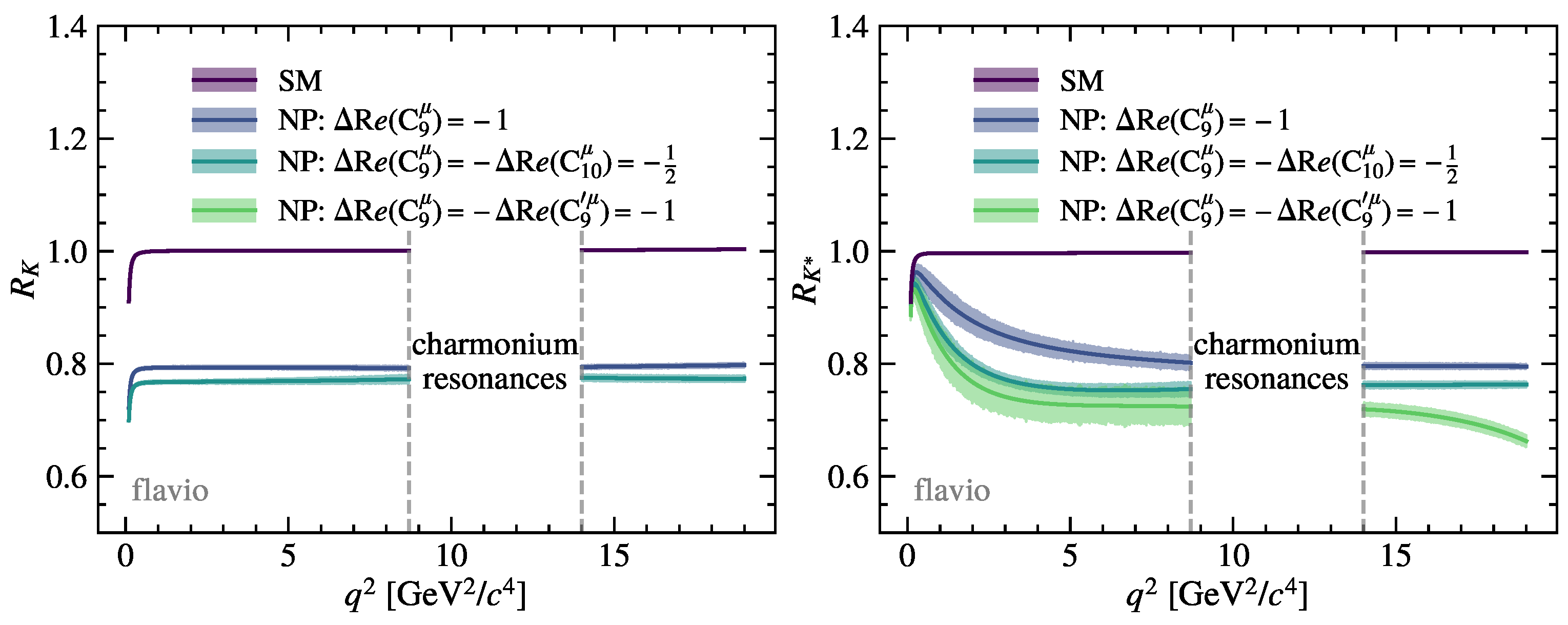


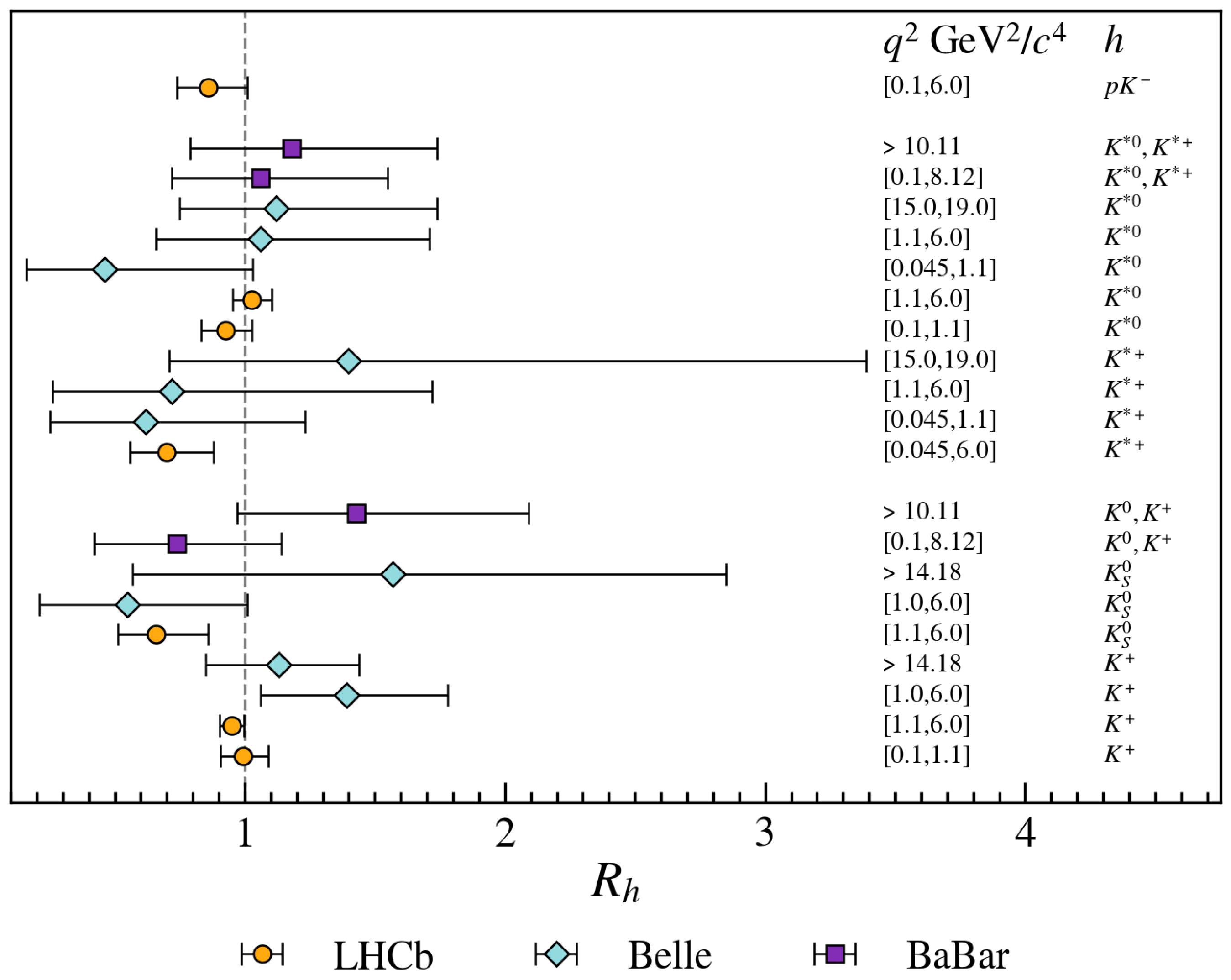
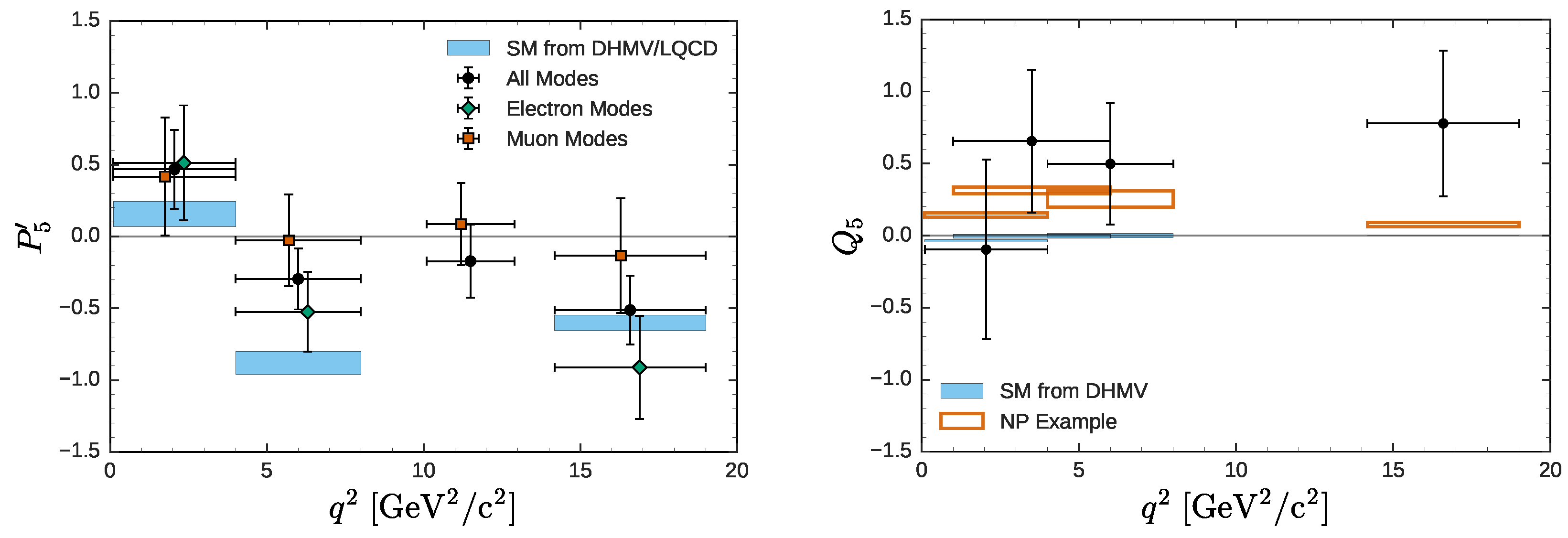
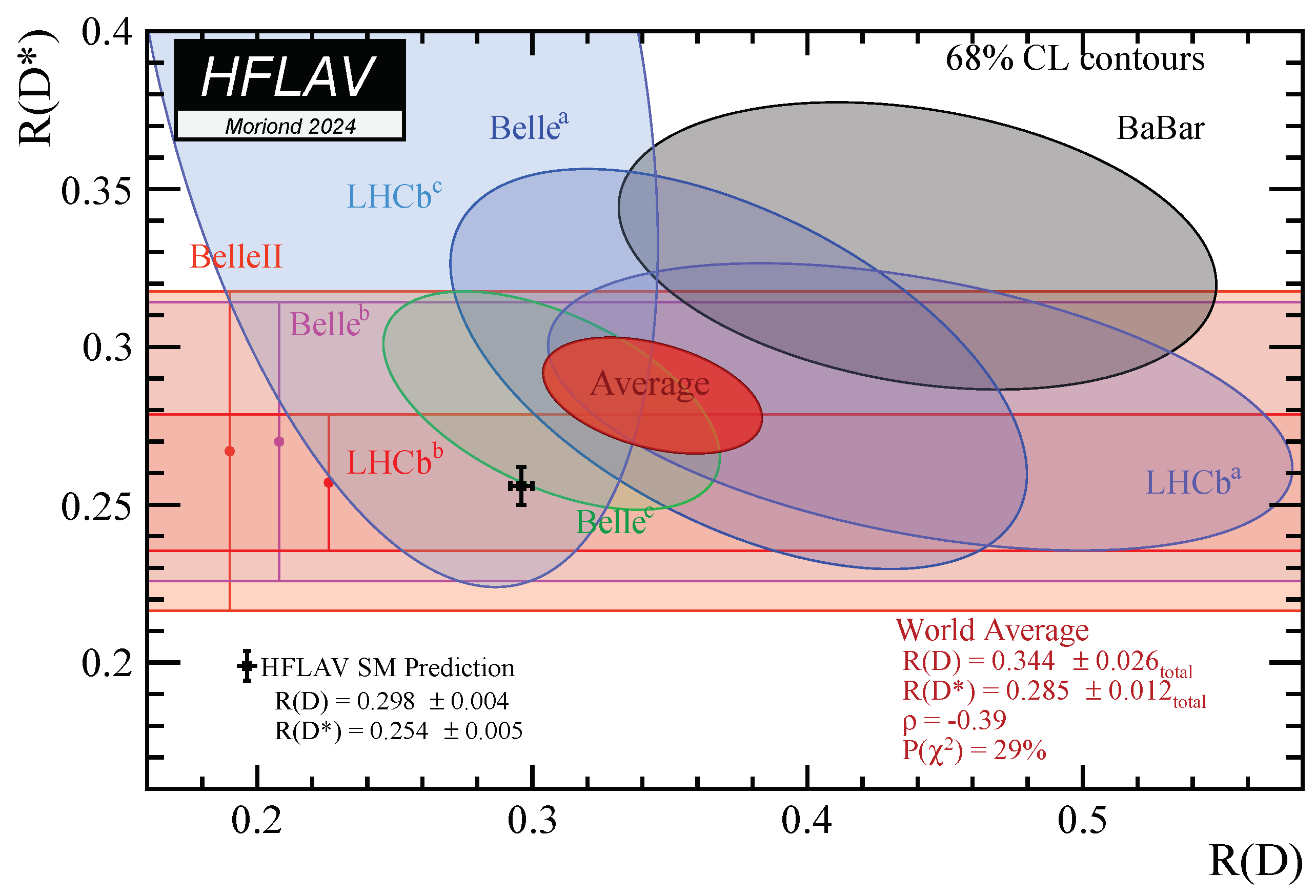
| Experiment | Integrated Luminosity | -Production Cross-Section |
|---|---|---|
| BaBar | 433 | 1.1 nb |
| Belle | 711 | 1.1 nb |
| Belle II | 190 | 1.1 nb |
| LHCb Run I | 3 | 72 μb |
| LHCb Run II | 6 | 154 μb |
Disclaimer/Publisher’s Note: The statements, opinions and data contained in all publications are solely those of the individual author(s) and contributor(s) and not of MDPI and/or the editor(s). MDPI and/or the editor(s) disclaim responsibility for any injury to people or property resulting from any ideas, methods, instructions or products referred to in the content. |
© 2024 by the authors. Licensee MDPI, Basel, Switzerland. This article is an open access article distributed under the terms and conditions of the Creative Commons Attribution (CC BY) license (https://creativecommons.org/licenses/by/4.0/).
Share and Cite
Álvarez Cartelle, P.; Williams, R.M. Lepton Flavour Universality in Rare B Decays. Symmetry 2024, 16, 822. https://doi.org/10.3390/sym16070822
Álvarez Cartelle P, Williams RM. Lepton Flavour Universality in Rare B Decays. Symmetry. 2024; 16(7):822. https://doi.org/10.3390/sym16070822
Chicago/Turabian StyleÁlvarez Cartelle, Paula, and Richard Morgan Williams. 2024. "Lepton Flavour Universality in Rare B Decays" Symmetry 16, no. 7: 822. https://doi.org/10.3390/sym16070822
APA StyleÁlvarez Cartelle, P., & Williams, R. M. (2024). Lepton Flavour Universality in Rare B Decays. Symmetry, 16(7), 822. https://doi.org/10.3390/sym16070822







